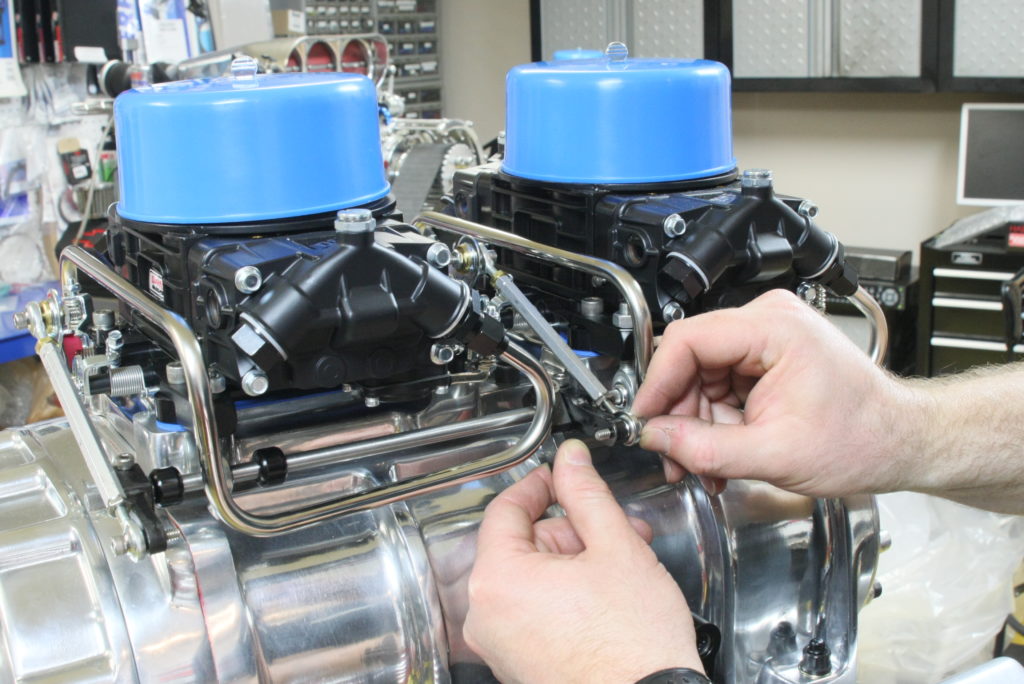Q: I built a 6-71 supercharged 355 c.i.d. Chevy. It ran fine for two summers until I took the car to the track to dial it in. On the fourth pass, the engine misfired through the blower. The blow-off valves on the supercharger intake manifold released like they were supposed to. When I got back to the pits, I found that the distributor shaft bushings had failed, which caused one of the points sets in the dual point distributor to close up, causing the backfire.
After replacing the bushings, points, and condenser, I reset the points and the blowoff valves. I also changed both power valves on the dual Holley carburetors. After doing all that, the engine would not run properly. The total timing before the misfire was 34 degrees; now the engine wanted more timing to run decently. I stripped the engine down, inspected all the internal parts, then reassembled it with a new block and crank, balanced the reciprocating assembly, and lapped the valves. The engine ran just the same—it wanted to run 42 degrees total timing before it would run smoothly.
I checked for vacuum leaks, but didn’t find any. The engine starts good and runs smoothly, but obviously detonation is a severe problem with that much timing. Should I do a leakdown test? Should I check out the supercharger for any problems?

A: We think your problem is electrical. When the distributor shaft bushings failed, they may have damaged the distributor body more than you thought. What we think you need to do is the dump the dual point and get an MSD electronic distributor and an MSD 6BTM ignition box. The distributor is extremely accurate, and the 6BTM has a Boost Timing Master control on it that will automatically adjust spark timing based on how much boost the supercharger is making. The 6BTM can adjust spark retard from one degree per pound of boost to three degrees per pound of boost, with a maximum retard of 15 degrees.
There is a possibility you have a problem with the harmonic damper. The outside ring may have slipped during the backfire, causing the timing marks to be off. You might want to check that out using a degree wheel with the engine at TDC on number one cylinder.
We ask the Summit Racing tech department a new tech question each week. If you’d like to read previous Mailbag features, please click here.

The “Monday Mailbag” Q&A section pertaining to the supercharged 355″ Chevy with ignition problems seemed almost like a test to see if anyone was paying attention.
The introduction begins by saying “This week in our Monday Mailbag, we’re trouble shooting ignition timing problems in a NATURALLY ASPIRATED SUPERCHARGED 355 Chevy”.
Automotive technology and descriptive terms are changing faster than ever but doesn’t “naturally aspirated” still refer to an induction system that operates at normal barometric pressure or the typical atmospheric conditions for a given altitude in reference to sea level ?
I’m also pretty sure that “supercharged” still refers to a type of forced induction that boosts the intake charge flow velocity to levels above a given normal atmospheric pressure by means of a mechanical device that’s driven by the engines crankshaft.
I don’t mean to split hairs but ” naturally aspirated supercharged” isn’t a common typographic error but we all make mistakes sometimes. It’s still a interesting topic even if very few readers actually drive a 355″ Chevy with a dual quad supercharged induction system. It does seem kinda strange that with all of that hi-tech hardware, the owner chose a Stone Age dual point distributor for his ignition system.
But on a positive note, your staff recommended an excellent MSD-6BTM ignition system for a huge step towards better performance. On the horsepower per cubic inch scale, that naturally aspirated supercharged 355″ Chevy should be close to a 393″ Ford Cleveland stroker with naturally aspirated single 4-V induction and alloy Cleveland aftermarket heads. That’s a no typo, dyno proven fact. And the beat goes on….
Yep, you got us on that one. It appears we may have merged two separate intro paragraphs together. It should’ve said simply “supercharged.” Thanks for your feedback; we have made the change.
I appreciate the timely manner in which “On All Cylinders” replied to and corrected the subject of my complaint. Your technical staff provides an excellent source of information to the readers. Thanks and keep the good stuff coming !
[…] Download Image More @ http://www.onallcylinders.com […]